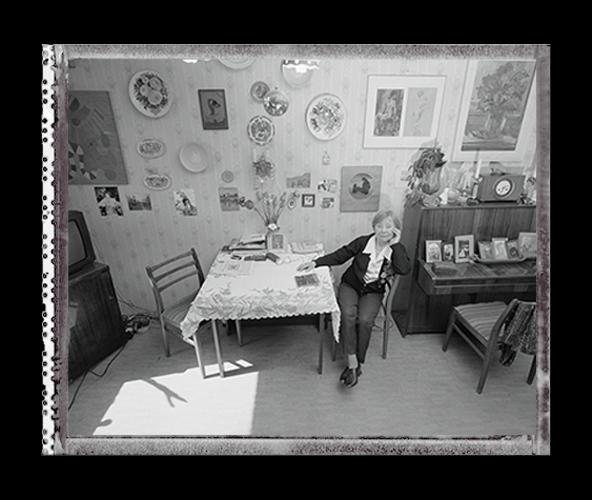Let me lead you into the apartment of a blokadnitsa, a woman who lived through the siege of Leningrad. After buzzing us into her nondescript Kruschnev building, she will meet us at the top of a dark stairwell. The metal door will create a cautionary barrier at first. But, don’t worry, she will relax and let us through. Once inside, notice the lace curtains, the papered walls and spindly plants on the kitchen windowsill. Let us turn the pages of her scrapbook as we sit together with her on a couch covered with carpet. Let us experience emotion as she tells us about the day her neighbor ate the family cat.
Consider the pieces in this exhibit as experiential art, for my encounters with the blokadnitsy became art itself. The process of spending hours with each of these women in their apartments, both in St. Petersburg and Moscow, drinking sweet tea and eating even sweeter cake took on an almost theatrical art form. And it was this experience that I have tried to capture and share with you through The Blokadnitsy Project.
To the westerner, the Siege of Leningrad is an unknown tragedy, easily overlooked among the jumble of WWII horrors on the eastern front. Sieges, or blockades, are notoriously difficult to report. Unlike traditional battles where military fronts offer access to first-hand accounts; blockades are quiet, hidden, and horrific. For years, the soviet desire to obscure mistakes and miscalculations during the defense of Leningrad made the situation even more opaque. Further, survivors have felt acute remorse for having lived when so many did not. Blokadnitsy are not inclined to talk about the tragedy. In fact, most of the women I met had never revealed their siege experiences, not even to their own children. Yes, the ones that survived were heroic, but they were also guilty of the terrible thoughts and acts that accompany mass starvation. The fact is, these survivors are full of shame.
Leningrad, now and formerly known as St. Petersburg, was the architectural jewel and capitol of Tsarist Russia. More than three times the population of Boston at the start of the siege, at least 400,000 of the 2.5 million civilians trapped in the city were children. It is these children, now 80 plus years old, who have fascinated me. Survival established their place in an extraordinary yet remorseful society. As Galina told me, “We are bonded by a strange fate. They even have a name for us, Blokadnitsy.”
Welcome to The Blokadnitsy Project. Follow me into the apartments and into the lives of twelve survivors of the siege. Follow me into a piece of history many have tried to forget. Follow me now, for the witnesses are soon to be no more.
I am hesitant to publish their stories on line. Yes, they agreed to the photo shoots and told me the stories knowing that I would use them in some way. They watched as my translator took notes occasionally I taped or made video recordings. But, let us remember their age. They are not always lucid and internet is a mystery to them. I doubt they could ever have imagined how public this project would become. For that reason, I have given them nicknames and also made artistic and ethical decisions about story placement and references. It is also important to remember that this is an art project; interviews, translations and themes are inherently subjective. Please read with care and compassion and let us not judge or create more trauma for these survivors.















